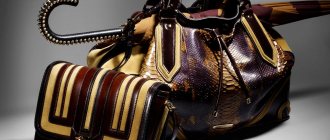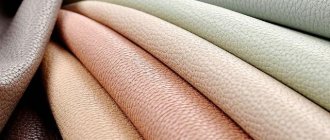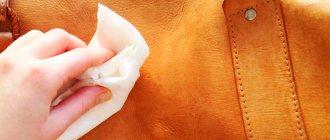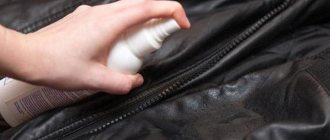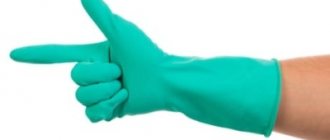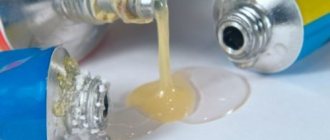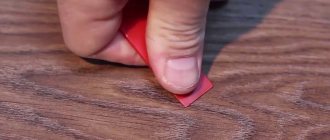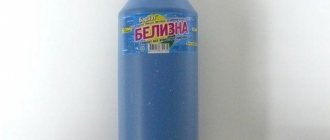When a person buys leather goods, he runs the risk of being deceived. Many sellers pass off leatherette products as genuine leather products. To avoid receiving counterfeit goods, you need to check them properly. More information about how to distinguish natural leather from artificial leather will be discussed in this article.
Look at the internal and external coating
You should take a close look at the texture of the accessory.
If you distinguish the pores, notice their symmetrical arrangement - most likely, you have a substitute in front of you. Natural raw materials have only random porosity and slightly noticeable wrinkles. The relief is harmonious, but not uniform. Hold a piece of cloth with your palm. Natural fabric will absorb moisture and quickly warm up, taking on your body temperature. Artificial fibers, on the contrary, repel sweat and leave a feeling of moisture on your hands. Squeeze the piece of paper with your fingers – there will be no creases or dents left on the real one.
According to processing methods and coloring, genuine leather is divided into:
- Nappa is a processed cattle breed characterized by softness, elasticity and even color. One of the most durable and most affordable types of natural textiles.
- Morocco is the name given to goat skins that can be tanned, lightly burned, and brightly dyed. More often it is used for the production of boots and bindings.
- Velor – chrome-tanned leather, finished like soft velvet on the side of the lining, through special grinding.
- Suede is the skin of non-large horned animals, characterized by a thick but not fluffy pile without shine, softness and pleasantness to the touch. Its front side is bakhtarmyanaya.
- Shagreen is a soft, vegetable-tanned skin that comes from sheep or goats. The surface of the products is distinguished by a beautiful and fine pattern with a relief texture.
- Laika is a product obtained by tanning with aluminum alum using salt, flour and yolk. The raw materials used are the skins of sheep, goats and dogs. The material is soft and very thin. This is what gloves are most often made from.
- Nubuck is a common material, a finely fleecy fabric, characterized by velvety and softness, obtained from a cow or calf. Visually and to the touch it is very similar to suede.
- Lacquer – a finish coated with a special varnish on top. Accessories made from it can only be worn at temperatures from −10 to +25 degrees and only in the absence of precipitation. Usually, spring ballet shoes, wallets, and inserts on clothes are made from it.
The best quality and comfortable bags made of genuine leather are sold by Piquadro. It has established itself as a reliable supplier of branded goods in the domestic market.
Look at the condition of the edges and seams
The best way to check and determine whether the leather in front of you is real or not is to study its surface and material from the inside. The inspection should begin from the inside out. Unfortunately, you cannot see it in all products. You can actually examine the structure by finding a section of tissue. Real leather is made from suede fibers, while leatherette is most often made from synthetics. Now another analogue is gaining popularity - eco-leather. And in terms of external characteristics, it is completely indistinguishable from natural, but its artificial origin is immediately revealed by the fabric lining.
There should be no threads sticking out of the stitched seam, the raw material itself does not delaminate, the reverse side is rough to the touch, fleecy, looks like suede, sometimes not finished dyeing. The paint in artificial fibers is absorbed much better, so the color is always bright and rich, unlike natural ones.
In order to check the quality of dyeing, you need to take a small piece of white cloth and moisten it in water. If you wipe the surface of an accessory with it and it does not stain, the item is made to last. However, there are very few such products on the modern market. Therefore, when purchasing even an expensive product, it is better to periodically treat it with water and dirt-repellent agents. They will help not only protect the outer material, but also ensure the durability of the shades. Otherwise, your brown bag may turn yellow over time.
Natural things are much more expensive, not only because they are of animal origin. Working with such a base is much more difficult. The skin is thicker and denser than its substitutes, and sewing elements together is not as easy as fabric ones. The edge of the craft is even and smooth, which cannot be the case on a leather cut. Expensive and high-quality products should have an even cut, without missed stitches and without traces of glue.
Reviews
Anna, 32 years old
I just love leather things! Over the years of wearing them, I have already learned to distinguish real material from artificial material by touch - it is really more natural and natural, resilient and elastic, immediately restores its shape and really heats up in the palm. It is difficult to tangle, especially if you squeeze it with your fingers and rub it lightly. So I can advise you to focus specifically on your tactile sensations, and determining by smell is risky - it is increasingly being counterfeited.
Dmitry, 26 years old
I was planning to buy a bag for my wife for her birthday, and I came across your article just in time. So many useful things. Previously, the only testing method I knew was ignition, but it’s clear that sellers will never agree to such tests. Now I know what to look for, where to feel, where to press - thank you.
Pay attention to the label
Natural shoes are always equipped with a small sticker with several symbols, which usually provides comprehensive information about the upper and lower parts of the accessory and the composition of the lining. A piece of the material from which it is made is also hung on a high-quality bag: in the form of a diamond for leatherette and irregularly shaped for leather goods. On a small section, the following lines are written, which will indicate how to identify genuine leather from a fake:
- genuine leather (in English);
- vera pelle (in Italian);
- cuir (in French);
- echtleder (in German).
However, even if the purchased product has a sample of the material used attached, this does not mean that the product is leather. This small section also needs to be verified for authenticity by any available means.
In order not to be deceived, natural things should be purchased only from trusted companies, at specialized points of sale. At bazaars, spontaneous markets or just on the street, you are not immune from counterfeiting. Upon request, you must be provided with a quality certificate and a guarantee for the product. The document must indicate the material from which the accessory is made, and be stamped and signed by a representative of the body issuing the certificate.
Price
Leather products cannot be cheap - this is the main rule that must be followed if you do not know how to determine the naturalness of leather. However, it all depends on which animal’s skin was taken as a basis.
- Budget jackets, shoes and linings are made from pork.
- Made from bull, hard and durable - various accessories: belts, bags and backpacks.
- From cowhide - items in the middle price segments, mainly shoes.
- Calf leather - handbags, clutches, shoes and jackets.
- From sheep - gloves, bags, belts and luxury outerwear.
- Expensive wallets, gloves, and men's wallets and purses are made from the delicate skin of goats.
- Premium products are made from the skins of exotic animals. These are jackets, raincoats, luxury shoes, bags and shoes made of crocodile, ostrich, and deer.
Another expensive material is patent leather. To obtain it, the canvas blank is primed and varnished on top, after which a spectacular glossy sheen appears. The advantage of such an acquisition is the variety of color palettes. Cover the surface with matte or glossy varnish. Lacquered raw materials are used to make bags, wallets, belts, and various inserts on clothes and shoes. But such accessories require special care. If the slightest scratch appears, things will look unkempt.
Types of genuine leather by animal type
Having learned how to distinguish leather from leatherette, it is important to know that it itself comes in several types that have different characteristics. For example, bovine leather is tough and thick and is used for sewing jackets, belts, and backpacks. Cow leather has less strength than calf leather and is used to make footwear in the budget sector. Calf is softer and quite durable; creases almost do not appear on it. The same soft and sheepskin leather is used to make gloves, jackets, bags and premium belts. There are also deer, goat, snake, crocodile and ostrich leather. And the same number of imitators and fakes.
How to check leather for authenticity: evaluate the smell of the product
Things made from low-quality leatherette generally emit a sharp and unpleasant aroma of chemical elements, reminiscent of plastic or oilcloth. It dissipates very slowly. Every person has encountered such an amber at least once when purchasing budget shoes. High-quality leather accessories have a subtle aroma.
It is worth understanding that, just like tags, unscrupulous manufacturers and sellers also fake the smell by sprinkling accessories with appropriate flavors or adding them to the raw materials at the manufacturing stage. However, the sharp chemical aroma of cheap analogues cannot be masked by anything.
Try testing the product with fire
Many people wonder whether genuine leather burns or not, because you don’t want to spoil a new product, just out of curiosity whether it’s real or not. And store sellers do not allow you to do such experiments before you have paid for the goods. But if you are sure of the origin of the purchase and want to prove its authenticity, you should not be afraid of fire. Under its influence, leatherette will immediately begin to melt, emitting smoke and a pungent odor. Sometimes the entire product flares up due to the fact that manufacturers treated it with special aniline mixtures. The natural material is not afraid of flame and emits a perceptible smell of spruce. If you don’t know how to quickly test leather for naturalness with fire, use a regular lighter or matches.
How are leather items decorated?
Contrary to the widespread belief that manufacturers of things try to pass off artificial materials as natural, factories supply their products with labels that honestly contain information. In any case, this is what European and North American manufacturers do.
In the West, genuine leather is not only not held in high esteem, but wearing items made from it is considered bad manners, unless we are talking about classic and vintage items. But high-quality eco-leather and other high-quality substitutes are at the peak of demand. Therefore, there is no need to hide the true material.
Testing with water
Another way is to drip a few drops of liquid onto the surface. Natural matter will immediately absorb it, leaving a characteristic dark spot. Synthetic analogues will repel it, but the color of the surface will not change in any way. But you shouldn’t rely too much on this method. Modern things, especially expensive ones, have long been treated with water-repellent mixtures in order to increase wear resistance and ease of use.
Special attention should be paid to suede
It is suede products that can most often be found on the market after ordinary leather ones. Often, several types of leather are combined in bags, shoes, wallets and clothing. Suede or varnish pieces are inserted. Chamois is the raw skins of deer, elk, sheep and young calves, richly soaked in fat. It is counterfeited using several methods: woven and non-woven. The first is special processing of microfiber threads under production conditions. The second is the usual gluing of pile on top of a textile flap. To distinguish suede from a fake, you need to:
- Estimate the cost. Suede products cannot be cheap. They are not for the wallet of a budget buyer, even with the maximum discount.
- Take the accessory in your palm and feel it. Natural matter quickly heats up and takes on the temperature of your body, and itself begins to radiate heat. Pseudo-suede will remain cold.
- The pile can be “combed” in any direction with the palm of your hand. The shade of the surface will change. The counterfeit hairs do not react to such manipulations and their color will remain the same.
- If the item is uniform in tone and texture, you are probably getting a fake. Natural suede will always have microdamages, scratches and cracks.
- The leather is elastic; if you bend it in half, a trace of a crease will appear, which quickly disappears, and the surface will return to its original appearance. With a fake it will be different - either the trace will not go anywhere, or it will not form at all.
What is eco-leather and what is it made from?
This is not eco-friendly leather, as many may think. It is made by people and no animals were harmed during the production process. The inventors set themselves the task of producing a material that would be as similar as possible to natural leather. They succeeded, because these materials are almost impossible to distinguish.
In the process of producing eco-leather, environmentally friendly raw materials are used. The basis of the material is cotton fabric, on which a layer of polyurethane is applied. Therefore, the product does not have any foreign odor and does not contain substances harmful to the body or the environment.
Some tips on how to check and determine whether leather is genuine or not
- Try not to buy leather products on the market, even if they convince you of the quality of the product and demonstrate checks in all the ways described above. Subsequently, the accessory will turn out to be rough, the seams will fall apart and the surface will fade after a short period of wear. Give preference to branded places of sale with a good reputation.
- Find out what animal the skin belongs to, especially if you are choosing clothes. Buffalo, calf or bull dressing is durable and will last 10 years, while pork is more affordable, but also has the ability to stretch and has a service life of 3-5 years.
- Pay attention to the country of origin. The best goods were brought from Italy and England. Sweden, Germany and France.
- Check the thickness - it should be identical over the entire surface or reinforced in the places where the zipper, armhole is inserted or handles are sewn on.
In the article we told you how to find out and understand whether leather is genuine or not. If you carefully examine the surface, look inside, at the seams and joints, and also remember all the recommendations of experts, you will definitely be able to distinguish a fake. The more ways you try, the more likely you are to find out the truth.
Shoes
Before buying leather shoes, you should decide on its naturalness. It is not recommended to wear shoes made of eco-leather, as the foot will not breathe and will sweat a lot. Genuine leather, on the contrary, will prevent your feet from sweating, getting wet or freezing. When you put on boots or boots made of genuine leather, you will feel incredible softness and elasticity, the product will adapt to the shape of your foot. Eco-leather cannot do this. Substitute shoes are usually very hard, rough and have a strong chemical smell. You can also look at the cut of the product; if you see a suede layer, then this means that this is definitely a natural material.
